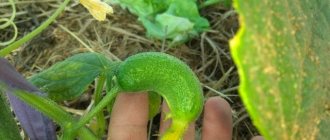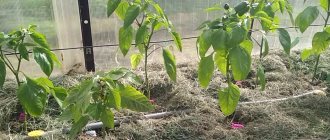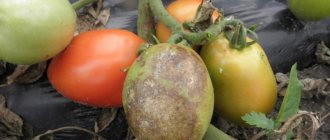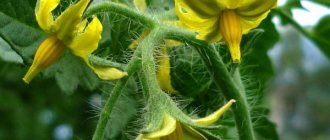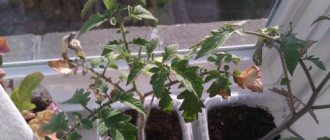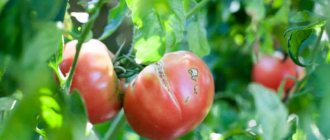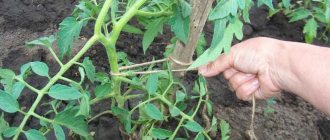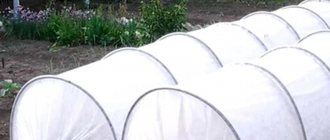Growing tomatoes has become familiar and accessible, thanks to the active work of breeders offering many varieties or hybrids for each region of Russia. Strong seedlings, suitable soil, and quality care promise a good harvest. But what should you do if, for no apparent reason, the leaves of tomatoes dry out and turn black in a greenhouse or open ground? The best option would be to carefully inspect the plantings, study the symptoms, and then compare them with descriptions of known diseases of nightshade crops.
Reasons for blackening of tomatoes
Despite the fact that the appearance of blackness on tomatoes is often caused by the spread of fungi, there are other indirect causes leading to the proliferation of pathogenic bacteria, including:
- insufficient lighting and ventilation;
- improper watering;
- soil moisture over 90%;
- dew and fog;
- large differences in day and night temperatures;
- incorrect dosage of fertilizers;
- too much nitrogen fertilizer;
- increased soil acidity;
- untimely stepsoning;
- violations in crop rotation: planting tomatoes instead of potatoes or peppers.
Darkening of fruits or plants themselves can be caused by the following diseases:
- late blight;
- gray rot;
- crown rot;
- Phomasis;
- macrosporiosis;
- brown spot.
The least late blight occurs in tomatoes in a greenhouse, because they are protected from external factors; approximately the same temperature and humidity are always maintained. The main reason for the spoilage of tomatoes in this case is soil depletion. Before planting seedlings in a greenhouse, it is necessary to carry out disinfection, and completely change the soil every 4-5 years.
Tomatoes grown in soil often turn black due to lack of calcium in the soil and other fertilizers, and they often suffer from high humidity during rainy August and September. In addition, tomatoes grown outdoors without trellises may begin to brown because the bushes sag under their own weight.
Symptoms, what it looks like, photos
In most cases, blossom end rot occurs on tomatoes that have grown to 30-50% of their full size, but can affect green fruit of any age. The disease often appears during the hottest period of summer.
First, at the top of the berry, that is, the “butt” area where the scar from the fallen flower remains, a light brown spot mixed with a yellow or green tint forms. The shape of the changed area is usually rounded and flattened.
Later, the affected area becomes depressed, darkens, often acquires a gray-brown color and gradually increases in size, going deeper. Sometimes the spot takes up a third of the fruit.
The tissue under the skin in the damaged area softens and rots. Rot can penetrate into the deep layers of the pulp. The fruit becomes dry and dense, grows slower, and takes on an irregular shape.
Sick tomatoes turn red before healthy berries and fall off the bushes prematurely. Their flesh loses its taste and juiciness and becomes hard.
In conditions of high humidity, the rotten area is inhabited by a colony of bacteria or saprophytic fungi. Because of this, the stain turns black or dark brown, can become moldy, crack, and often develops weeping rot.
In the latter case, the affected tissues become soft, emit an unpleasant odor, the stain grows and soon the entire fruit rots.
Tomatoes in the lower part of the bush are most often infected, primarily those that touch the ground.
Top rot can also occur in a latent form, without changes in the outer part of the fruit. But in the pulp of healthy-looking berries, black areas of rot are found; such tomatoes turn out to be dry and tasteless.
Features of blackening
Based on the affected area of the plant, it is easy to identify the cause of the disease and successfully overcome it. There are several forms of blackening of tomatoes, for each there is a specific way to combat it.
The tips of the tomatoes are turning black
The tips of the fruits darken not because of diseases, but because of improper maintenance conditions: insufficient ventilation in the greenhouse, “burns” from nitrogen fertilizers, lack of proper pinching of tomatoes.
Compared to other types of blackening of tomatoes, this is the most harmless. With a timely response, the fruits can be revived and good harvest ripening can be achieved.
Leaves turn black
Being affected by pathogenic bacteria, tomato leaves not only darken, but also curl, lose moisture, dry out and fall off. The size of the green area is noticeably reduced, so the process of photosynthesis is rapidly reduced, which can potentially lead to damage to the crop and even the death of the bush.
Leaves turn black due to damage by various fungi, such as:
- late blight;
- macrosporiosis;
- bacterial spot;
- wet and crown rot;
- gray leaf spot;
- septoria;
- tomato wilt virus.
Usually they develop due to improper conditions (excessive or insufficient humidity, temperature changes), but there are cases when the leaves begin to turn black due to unfavorable external factors - subzero temperatures, severe frosts or cool soil. In hot regions, darkening of tomato foliage is associated with high air temperatures and muggy weather.
Tomato leaves are one of the most vulnerable parts of the bush. If the foliage of a bush begins to turn black, this can be an alarming signal: you need to urgently respond and carry out appropriate treatment, otherwise the fungus can quickly spread to the fruits and trunk.
Treatment of spoiled bushes should be carried out with chemical or biological preparations; other methods will be ineffective. As for tomatoes growing in warm regions, they cannot be cured: they must be removed and the diseased bushes burned.
On the root
The cause of black roots or root collars is most often blackleg damage (root rot) of tomatoes. The first disease is associated with excessive watering and planting density, the second is caused by a number of factors: mechanical damage to the roots or neck, sudden temperature changes, planting seedlings in cold soil, and the rapid proliferation of pathogenic microbes in such an environment. Blackleg lesions can be eliminated by treatment with a medicinal drug. To get rid of root rot, you need to take the following steps:
- carry out disinfection with a chemical solution;
- remove diseased seedlings (bushes);
- mulch tomatoes in a greenhouse or open ground for the germination of new, healthy roots.
Do you do preventive treatments for tomatoes?
Yes
No
Why does the stem turn black?
Tomato stem necrosis and darkening is an extremely severe form of plant wilting. Usually, before the stem begins to turn black, there is extensive spread of the fungus, so it will be very difficult to ignore the deteriorating condition of the tomatoes: most of the leaves will turn black and dry out, and the fruits themselves will begin to deteriorate right on the branch. Thus, blackening of the trunk of tomatoes is more likely a consequence of general damage to the bush, and not the first sign of the disease.
The cause of the disease will need to be judged by the degree and nature of damage to other parts of the tomato: foliage, fruit, and root collar. This is the only way to accurately determine the type of fungus and select the appropriate drug for treatment.
Why do green tomatoes turn black?
If blackening is present only on the surface of the fruit, then the problem lies in improper maintenance conditions: a deficiency of minerals in the soil, an excess of nitrogenous fertilizers. In this case, spraying with saline solution will help.
In the case when not only green fruits are affected, but also the leaves around them, then we are talking about the proliferation of a pathogenic fungus: late blight, gray or apical rot. To eliminate it, you should treat it with a chemical preparation (for each type of fungus - a specific product).
Tomatoes turn black after harvest
Tomatoes, in principle, are not suitable for long-term storage; over time, all the fruits quickly turn black, so immediately after picking them, you need to select specimens with a good uniform color, and those that have brown/black spots or inclusions should be eaten first.
If it seems that the collected tomatoes are turning black suspiciously quickly, then the fact is most likely that the plant was infected with fungal spores of fusarium or anthracnose while still in the garden. Such tomatoes can continue to be eaten by cutting off the excess darkened parts of the fruit.
Cladosporiosis
Brown spot or cladosporiosis most often affects tomatoes grown in winter greenhouses. The source of the disease is neighboring plantings, last year's plant debris, contaminated soil or seeds.
Symptoms of cladosporiosis:
- The plant wilts with sufficient watering.
- Yellow streaks or spots appear on the upper side of the leaves.
- The bottom of the tomato leaf is covered with a brown coating.
- Affected leaves darken and curl over time.
- The ovary or unripe tomatoes lose their juiciness and dry out.
What to do first when cladosporiosis is detected:
- Weed the tomatoes and clear the beds of vegetation.
- Cut and then burn diseased shoots.
- Treat the bushes with fungicides or preparations based on copper compounds.
Why do tomatoes turn black when dried?
Blackening of tomatoes during drying is a common phenomenon; it is usually associated with violations of fruit processing technology. These reasons are the most common:
- the temperature is not high enough (drying should be done at a temperature greater than 45°C);
- long periods of exposure to direct sunlight (over a whole day of exposure to the sun, the crust of tomatoes simply burns);
- poor-quality cutting of fruits - ideally, the pieces should not be thick, only then will it be possible to preserve their natural color;
- drying in a gas oven.
If the black crust does not cause a deterioration in taste, then dried tomatoes can be stored all winter and served with any dish.
Tomato varieties resistant to blossom end rot
Variety White filling
Even among modern varieties and hybrids, it is difficult to find tomatoes that are 100% resistant to blackening of the tips. Poor agricultural technology can provoke disease even with high immunity. But several representatives of tomatoes can be recommended as the most unpretentious to growing conditions:
- “White filling” is an early variety recommended for open ground; determinate, with oblong red-orange fruits weighing 80-130 g;
- "Benito" is a determinate hybrid of medium ripening; plum tomatoes, red, weighing 100-120 g;
- “Bolshevik” is a determinant of early ripening; in greenhouses, with proper formation, the bush grows up to 1.5 m; produces round, deep red, multi-chambered fruits with firm flesh; average weight – 180-200 g;
- “Zhenaros” - a hybrid recommended for greenhouse cultivation; refers to the indeterminants of the average ripening period; the fruits are dense, slightly ribbed, with a small dark spot on a red background;
- “Pandarose” is an extremely early indeterminate, ripens in 70 days; the bush can grow up to 2 m in height; fruits are sweet, pink, semicircular, weighing up to 250 g;
- "Raisa" is another early indeterminate - the growing season is 2 months; the fruits are famous for their presentation, have the same round shape and dark red color; average fruit weight - about 150 g;
- “Semko 98” is an early-ripening hybrid determinant half a meter high; characterized by the uniform ripening of smooth, flat-round fruits weighing 65-80 g;
- “Pharaoh” is a mid-season, super-tall hybrid that produces up to 12 kg of sweet and sour, aromatic, fleshy red fruits from one bush;
- “Frontero” is a mid-early tall hybrid that produces flat-round red fruits weighing up to 115 g; The hybrid is characterized by high productivity and marketability.
Particular care should be taken when choosing tomatoes from early varieties. They are most susceptible to putrefactive damage.
It is possible to avoid blackening of the tips of tomatoes if you take a number of preventive measures and strictly follow the rules of agricultural technology. But if infection occurs, the diseased fruits are removed without regret, and the bushes with the remaining healthy vegetables are disinfected. You should not ripen such tomatoes and collect seeds from them - blossom end rot is transmitted genetically.
Prevention methods
To prevent blackening of tomatoes even before planting, you need to take the following measures:
- Choose the right place to plant tomatoes: new bushes cannot be planted where potatoes, peppers or physalis used to grow. If the seedlings are placed in the same place in the garden where tomatoes used to grow, then the soil must be completely renewed and replaced (in order to avoid the proliferation of last year’s spores).
- Check the irrigation of future beds: rainwater should not stagnate for a long time.
- Attach a trellis to each bush and tie up new shoots in time.
During the ripening of the crop, it is also necessary for prevention:
- Ventilate the greenhouse with fresh air from the street at least once a day.
- Apply balanced fertilizers without excess nitrogen.
- Protect from sudden temperature changes (cover with polyethylene in a timely manner).
- Water the bush only at the root, avoiding direct contact of water with the leaves.
Folk remedies
During the fruit growth phase, when blossom end rot appears, many gardeners are wary of using mineral fertilizers. For feeding, you can use natural sources of calcium.
Wood ash
The leader in calcium volume is the ash obtained from burning deciduous trees; the microelement can occupy up to 30% of it. Ash also contains a lot of potassium and phosphorus.
For emergency treatment of blossom end rot, use ash decoction. Sift 3 kg of ash, pour in 10 liters of water, bring the solution to a boil and keep on low heat for 15 minutes.
Strain the broth and dilute each liter with a bucket of water. Use for spraying.
For prevention when planting seedlings, you can add wood ash to each hole. A glass of sifted ash is required per plant.
After pouring it into the hole, mix the ashes with soil and fill with a liter of water. After this, you can plant the bush.
Eggshell
To feed the planting, water it with infusion from the shell. The disadvantage of this product is that it will take about a week to prepare it.
More suitable for the second or third feeding during treatment, as well as for the prevention of calcium deficiency.
The shells of 10 eggs are enough to fertilize 8 bushes. Grind dry, clean raw materials in a coffee grinder, pour in a liter of boiling water and leave to steep for 5-7 days. Shake from time to time to enhance fermentation processes.
Before watering, dilute each liter of infusion with 3 liters of water; filtering is not necessary. Pour 0.5 liters of product under the bush. Repeat feeding after 2-3 weeks.
Ground eggshells are embedded during digging to reduce acidity and loosen the soil.
You can also add 1 teaspoon to each seedling hole. But even in a compost pit, the egg shells decompose for at least 2 years, and in the soil the process takes even longer.
In acidic soil, 1.5 kg of shells per 1 m2 should be added, this requires 300 eggs. If the soil is very acidic and heavy, add 3 kg of raw materials.
But you cannot contribute the entire amount at once, only in parts over several years. Optimally - 200 g (50 eggs) per 1 m2 per year in two passes - during spring and autumn digging.
The shells should be cleaned and dried before use. If this is not done, animal debris will attract pests to the planting. To preserve the raw material for a long time, it is advisable to bake it in the oven.
During heat treatment, a certain proportion of calcium is lost, but it is released more intensely during decomposition. The greatest loss of microelement occurs during cooking.
Brown eggs have thicker shells, like those laid in winter.
Chalk and vinegar
The reaction between chalk and vinegar produces calcium acetate. This is an organic salt that dissolves easily and is available to the roots.
This fertilizer is well suited for the treatment of blossom end rot because the plants get nutrition from it very quickly. Acetate is also beneficial for soil microflora.
Pour 200 g of chalk into 1 liter of 9% vinegar. Pour the vinegar in small portions, otherwise the reaction will be too violent and some of the product may “run away.”
When the chalk stops fizzing when adding a new portion, do not add the rest of the vinegar, otherwise the solution will turn out to be too sour. Dilute the product with 10-12 liters of water and use it to water the bushes.
Chalk can be replaced with ground eggshells. For 1 liter of vinegar you will need about 40 shells. Dilute a glass of this product with 10 liters of water.
Water the plants, spending 0.5-1 liters per plant. This solution can also be used for foliar feeding.
Calcium acetate absorbs phosphoric acid ions, and phosphorus deficiency may occur after using the product. Therefore, after a couple of days, apply additional phosphorus fertilizing.
Fighting methods
Most often, blackening of tomatoes is associated with the spread of a pathogenic fungus, so in most cases treatment must be carried out by treating with a chemical agent.
If fruit spoilage is associated with a violation of housing conditions (insufficient ventilation, excess nitrogenous fertilizers), then the cause must be eliminated by a reverse action: for example, improve the ventilation of the greenhouse, add more calcium-containing fertilizers.
Chemicals
Over the past decades, the following drugs have proven themselves to be effective (the standard dosage of the drug is indicated in parentheses):
- ecopin (0.5 g/5 l);
- infino (2.5 tsp/5 l);
- acrobat (20 g/5 l);
- metaxyl (40 g/5 l);
- ditan M-45 (8 g/5 l).
Before feeding, you must carefully read the instructions for the drug. Often, treating plants with a five-liter solution is not enough. For a large lesion, this volume is too small and the dose needs to be increased (10 liters or more).
Chemical treatment should be carried out cyclically for 1 time every 2-4 weeks (depending on the condition of the bushes).
Folk remedies
Home remedies to combat blackening of tomatoes are no less effective than chemical ones. Most people commonly use the following solutions for spraying tomatoes:
- garlic (using chopped arrows or heads);
- lactic;
- saline;
- mushroom (with chopped tinder fungus);
- manganese;
- solution of brilliant green or iodine.
For greater effectiveness, some components can be combined, for example, a milk solution can be mixed with 40-45 drops of iodine in 5 liters of water.
Since folk remedies are more environmentally friendly, their cyclicity can be increased (for example, spray the bushes every 7-10 days).
If tomatoes turn black, this is a serious sign of systematic wilting of the plant, so it is necessary to respond to this phenomenon as quickly as possible. Using chemical or traditional methods of control, it will be possible to save the harvest in a timely manner and without deteriorating the taste.
Alternaria blight
Dry rot, as Alternaria blight is otherwise called, is a fungal infection common to all nightshades. The disease manifests itself at any stage of the growing season and affects not only the leaves of tomatoes, but also the stems or fruits. The bush begins to turn black, dry out and may die completely.
Alternaria symptoms:
- The above-ground part of the plant is covered with small dark concentric spots.
- The affected areas enlarge, turn black and dry out.
- The surface of the lesion is covered with a coating of spores.
- The disease causes necrosis of inflorescence tissue, starting from the stalk.
- The spots on the leaves turn black, and a yellow halo appears along the edges.
- Black areas on the stems dry out and crack.
- Dark circles cause cracks in ripening tomatoes.
Disease control includes:
- spraying with fungicides or biological products;
- normalization of watering;
- ventilation of the greenhouse.
Can spraying baking soda help stop blossom end rot?
If you are a supporter of organic farming, at the initial stage of damage to tomato plants by blossom end rot in a greenhouse, it makes sense to protect the plants from possible infections with a baking soda spray. Baking soda spray on tomatoes does not actually kill the fungi, but the sodium bicarbonate changes the pH balance of the foliage so the fungal spores cannot germinate. Therefore, in the initial stages of infections, baking soda is used as a preventative fungicide, but it does not spray well and does not adhere well to foliage. Adding horticultural oil or dish soap to the solution will give the spray some stickiness.
Prepare a solution with which you think you protect tomatoes from diseases, add a heaped tablespoon of baking soda, a teaspoon of vegetable oil and a small amount of fairy to a bucket of water and spray the tomato plants with this solution the day before harvesting, let the spray dry in within one to four hours. Avoid spraying plants in direct sunlight or at temperatures above 26°C, otherwise you risk burning the foliage. Spray early in the morning or evening when it is cool. In outdoor areas, reapply baking soda sprays after heavy rain.
Baking soda can accumulate in the soil, robbing it of magnesium and calcium, leaving plants unable to absorb iron. This can cause the leaves to turn yellow or the growth of your tomatoes to slow down. Try not to use baking soda sprays more than once every 14 days.
You can read more about the uselessness of using soda in the garden here >>>
Tips, secrets
There are several tips that will make the life of summer residents much easier and help them avoid damage to tomatoes. Here are some of them:
- Before you start germinating the seeds, warm them up in the oven for just a few minutes.
- Complex fertilizers will help increase plant immunity.
- Leave space between bushes. The optimal gap is 30 cm. If the disease affects one of the bushes, the virus or fungus will not have time to spread to the neighboring plant.
- Pierce the base of the seedling trunk with copper wire.
- After each watering, be sure to hill up each bush.
Viral
A large group of diseases in tomatoes is a group of viral diseases. The causative agent is a virus; depending on the type of pathogen, the following diseases are distinguished:
- streak;
- aspermia;
- mosaic;
- bacteriosis;
- chloratic leaf curl;
- stem necrosis.
Briefly about each of this list of diseases and how to treat them.
Streak
The streak looks like brownish-reddish strokes, rounded spots and stripes. The disease must be prevented and for this it is necessary to choose only high-quality seeds for planting and grow varieties only in good lighting.
The soil in the greenhouse must be constantly loosened and replaced. An excellent method of prevention is the use of insecticides. There is no point in treating a sick plant - it needs to be removed from the site as soon as possible.
Aspermia
Aspermia entails inhibition of the growth of the main shoot and deformation of the upper leaves.
Several ways that help in the fight against aspermia:
- Fighting aphids.
- Destruction of weed vegetation.
- Remove infected plants promptly.
- Do not allow tomatoes and chrysanthemums in the same greenhouse.
- Treat bacterial diseases of tomatoes in a timely manner.
Mosaic
Externally, the mosaic really resembles a mosaic - it is an alternation of a light green leaf and a normal one. The leaf shape gradually becomes fern-like. Pinching and processing helps. If there is a sick plant, you just need to remove it from the garden. Treatment (disinfection) of soil and plants are preventive measures.
Bacteriosis
Outwardly, this is ordinary wilting, but we are not talking about a lack of moisture. These symptoms can occur overnight. The inside of the plant stem will have a brown tint.
Therefore, diseased bushes simply need to be eliminated. Neighboring plants must be treated with special solutions.
Chloratic curl
The tops of the plant become curled up and this is a prerequisite for the appearance of another disease. Curly disease is transmitted through seeds and soil. Therefore, urgently remove dead plants and treat the soil.
Stem necrosis
The stem begins to darken, but the leaves at the top begin to fade. This is how stem necrosis manifests itself
There is a group of tomatoes that are tolerant to this stem necrosis and are worth paying attention to. Chemicals can only destroy the pathogen on the stem, but they cannot penetrate inside and are therefore ineffective
The diseased plant must be eliminated.
How to prevent the disease from spreading next year
The problem is easier to prevent than to fight. You notice damaged fruits, blackened leaves, and dried stems in the garden, which means the tomatoes are sick. Prevent the infection from spreading next year.
Precautionary measures:
- plant marigolds, mustard, and calendula in the garden, which prevent the spread of diseases;
- disinfect the soil with a 1% solution of potassium permanganate;
- remove plant waste from the garden;
- prepare healthy seeds for planting;
- choose varieties that are resistant to infections;
- mulch the ground with pine needles, straw, hay;
- treat the greenhouse with a 1% solution of copper sulfate.
Recommendations from gardeners
Experienced farmers have learned to cope with tomato diseases, and everyone has their own secrets.
Katya : “In the greenhouse we fight late blight in this way: we water it once or twice a week, we constantly mulch the soil to retain moisture. The method of warming up the greenhouse helps get rid of fungi. In hot weather, we close the greenhouse for a couple of hours; late blight does not like this.”
Sergey : “I grow tomatoes in a greenhouse, I recently noticed black spots on the bushes. To preserve the harvest, we had to pick off the green fruits. For disinfection purposes, I soaked it in hot water at 60˚C for two minutes and stored it in boxes. Copper sulfate was splashed in the greenhouse.”
Ivan: “I fight tomato disease in my grandmother’s way - I spray it with milk and iodine. As soon as I notice signs of disease, I pick off all the fruits. Then I prepare a solution: I dissolve a small bottle of iodine in a bucket of warm water. I immerse tomatoes without cuttings in the solution for 20 minutes, take them out, dry them and store them in boxes. I water the ground and bushes with a solution of milk and iodine.”
